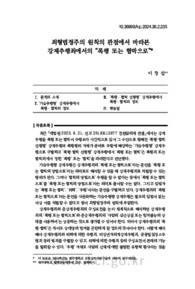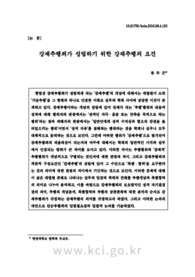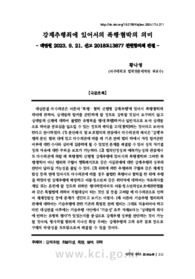

PARTNER
검증된 파트너 제휴사 자료
강제추행죄에서 ‘폭행 또는 협박’의 의미 (Meaning of ‘Violence or Intimidation’ in the Crime of Indecent Act by Compulsion)
48 페이지
최초등록일 2025.06.30
최종저작일
2023.12

-
미리보기
서지정보
· 발행기관 : 사법발전재단
· 수록지 정보 : 사법 / 1권 / 66호 / 989 ~ 1036페이지
· 저자명 : 이준민
초록
대상판결의 쟁점은 폭행 또는 협박이 추행보다 시간적으로 앞서 그 수단으로 행해진 이른바 ‘폭행·협박 선행형 강제추행죄’에서 상대방의 항거를 곤란하게 하는 정도의 폭행 또는 협박이 요구된다고 판시한 ‘종래의 판례 법리’(대법원 2012. 7. 26. 선고 2011도8805 판결 등)를 유지할 것인지 여부이다.
이에 관해서는 강제추행죄의 ‘폭행 또는 협박’은 상대방의 항거를 곤란하게 할 것을 요구하지 않고, 상대방의 신체에 대하여 불법한 유형력을 행사(폭행)하거나 일반적으로 보아 상대방으로 하여금 공포심을 일으킬 수 있는 정도의 해악을 고지(협박)하는 것이라고 보아야 한다는 견해(제1설), 상대방의 항거를 곤란하게 하는 정도의 폭행 또는 협박이 요구된다고 판시한 ‘종래의 판례 법리’는 여전히 타당하므로 그대로 유지되어야 한다는 견해(제2설)를 상정할 수 있다. 제1설은 강제추행죄에 관한 현행 법규정이 폭행·협박의 정도를 명시적으로 한정하고 있지 않고, 피해자의 ‘항거곤란’을 요구하는 것은 강제추행죄의 보호법익이 정조가 아닌 헌법 제10조에 근거한 자유로운 개인의 성적 자기결정권인 점과 부합하지 않으며, 폭행·협박을 수단으로 원하지 않는 성적 행위를 하게 된다면 그로써 강제추행죄의 보호법익인 성적 자기결정권은 침해된다고 할 것이고, 근래의 재판 실무는 종래의 판례 법리에도 불구하고 가해자의 행위가 폭행죄에서 정한 폭행이나 협박죄에서 정한 협박의 정도에 이르렀다면 강제추행죄의 성립을 인정하는 방향으로 운영되어 왔으므로, 사실상 변화된 기준을 적용하고 있는 현재의 재판현실과 종래의 판례 법리 사이의 불일치를 해소할 필요가 있다는 점을 주된 논거로 한다. 제2설은 종래의 판례 법리는 강제추행 중 ‘강제’ 부분에 관한 법문언과 ‘항거곤란’을 기초로 마련된 성범죄 관련 특별법과의 체계에 부합하고, 준강제추행죄에서 항거불능을 요구하는 것과 해석상 균형이 맞으며, 종래의 판례 법리는 피해자의 현실적 저항을 요구하거나 2차 피해를 야기하는 법리가 아니고, 대법원이 수십 년 동안 반복적으로 선언한 법리로 학계의 지지를 받고 있으며, 이른바 ‘종합판단기준설’을 통해 구체적 타당성도 도모할 수 있는 법리로, 강제추행죄에 관한 종전의 판례 법리를 바꾸어 처벌범위를 확대하는 것은 국회의 입법절차를 통하여 해결하는 것이 바람직하다는 점을 주된 논거로 한다.
대상판결은 심도 있는 논의를 거쳐 제1설을 다수의견으로 채택하고, 종래의 판례 법리를 변경하였다. 한편 대상판결의 다수의견에 의할 경우 앞으로 기습추행과의 관계를 어떻게 설정할 것인지, ‘추행’의 의미를 어떻게 볼 것인지에 관해 다수보충의견들이 개진되었다. 대상판결은 대법원이 강제추행죄에 대하여 ‘항거곤란’을 요구한 종래의 판례 법리를 폐기하고, 그로써 종래 법리와 현재의 재판 실무 사이의 불일치를 해소하며, 일반인들에게 금지된 행위와 허용된 행위의 경계를 분명히 이해하고 그에 따라 이를 행위규범으로 수용하도록 하는 것에 의미가 있다.영어초록
The gist of the subject case pertains to whether to uphold the legal doctrine set by precedents concerning a so-called “crime of indecent act by compulsion preceded by violence or intimidation”, i.e., a criminal offense in which violence or intimidation was employed, as a means of committing an act of indecency, prior to the commission of indecency in temporal terms, stating that violence or intimidation must reach a degree of making the victim unable to resist (Supreme Court Decision 2011Do8805, Jul. 26, 2012).
There are two perspectives: (a) “violence or intimidation” in the crime of indecent act by compulsion (hereinafter “forcible indecency”) is not necessarily required to reach a point of making resistance impossible, but rather, it means either to unlawfully use force on another person’s body (violence) or to warn of harm to the point of terrorizing the victim (intimidate); or, on the contrary, (b) the previous legal doctrine set by precedents, which concluded that there has to be violence or intimidation severe enough to cause the victim’s inability to resist, still remains valid and should therefore be upheld.
The first view is based on the following rationale: (a) the existing statutory provisions concerning the crime of forcible indecency do not set forth an express limit on the severity of violence or intimidation; (b) requiring the victim’s inability to resist is in dissonance with the interest intended to be protected against the crime of forcible indecency, which is not chastity but the individual right to sexual self-determination based on Article 10 of the Constitution of the Republic of Korea; (c) if a victim is drawn into unwanted sexual activities due to violence and intimidation, his or her right to sexual self-determination, which is a legally protected interest against the crime of forcible indecency, would be infringed; (d) the recent court trials over the crime of forcible indecency have largely found the crime established if the offender’s act rose to the point of violence or intimidation as stated in the crime of violence or the crime of intimidation; and (e) the disparity between the present practice of the court that applies de facto revised standards and the previous legal doctrine of precedents needs to be resolved.
On the other hand, the second view is based on the following rationale: (a) the previous legal doctrine set by precedents coincides with the statutory text concerning “compulsion” in the crime of indecent act by compulsion and special acts concerning sexual crimes focused on the victim’s inability to resist; (b) the previous legal doctrine set by precedents also strikes a reasonable balance of interpretation with the crime of quasi-indecent act by compulsion that requires the inability to resist of the victim; (c) the legal doctrine set by precedents neither requires the victim to have actually mounted resistance nor causes secondary damage, but rather, it has been repeatedly proclaimed by the Supreme Court for the past few decades and is supported by the academia; (d) the legal doctrine set by precedents is a legal doctrine by which concrete reasonableness can be achieved in individual cases through a so-called “theory of standards for comprehensive determination”; and (e) the scope of punishment can be expanded better by the legislative procedures of the National Assembly than by making changes to the legal doctrine set by precedents concerning the crime of forcible indecency.
The subject case adopted the first view through careful deliberation and changed the previous legal doctrine set by precedents. In the subject case, Justices wrote opinions concurring with the Majority Opinion concerning how to delineate the boundary with surprise indecency and define the meaning of “indecency,” both of which are the issues that will be raised subsequently if following the Majority Opinion of the subject case. The significance of the subject case is that it abolished the legal doctrine set by precedents, which set forth a requirement of “the victim’s inability to resist” in the crime of forcible indecency, thereby resolving the disparity between the previous legal doctrine and the present court trial practices and allowing the general public to clearly understand the boundary between prohibited and accepted acts and accordingly adjust their behaviors in line with this newly set norm of conduct.참고자료
· 없음태그
- # crime of indecent act by compulsion
- # violence or intimidation
- # surprise indecency
- # inability to resist
- # Article 298 of the Criminal Act
- # right to sexual self-determination
- # victim stereotype
- # Secondary Harm
- # Use of Force
- # simple indecency
- # theory of standards for comprehensive determination
- # act of indecency
- # sexual crimes without consent
- # 강제추행죄
- # 폭행 또는 협박
- # 기습추행
- # 항거곤란
- # 형법 제298조
- # 성적 자기결정권
- # 피해자다움
- # 2차 피해
- # 위력
- # 단순추행
- # 종합판단기준설
- # 추행행위
- # 비동의 성범죄
-
자주묻는질문의 답변을 확인해 주세요

꼭 알아주세요
-
자료의 정보 및 내용의 진실성에 대하여 해피캠퍼스는 보증하지 않으며, 해당 정보 및 게시물 저작권과 기타 법적 책임은 자료 등록자에게 있습니다.
자료 및 게시물 내용의 불법적 이용, 무단 전재∙배포는 금지되어 있습니다.
저작권침해, 명예훼손 등 분쟁 요소 발견 시 고객센터의 저작권침해 신고센터를 이용해 주시기 바랍니다. -
해피캠퍼스는 구매자와 판매자 모두가 만족하는 서비스가 되도록 노력하고 있으며, 아래의 4가지 자료환불 조건을 꼭 확인해주시기 바랍니다.
파일오류 중복자료 저작권 없음 설명과 실제 내용 불일치 파일의 다운로드가 제대로 되지 않거나 파일형식에 맞는 프로그램으로 정상 작동하지 않는 경우 다른 자료와 70% 이상 내용이 일치하는 경우 (중복임을 확인할 수 있는 근거 필요함) 인터넷의 다른 사이트, 연구기관, 학교, 서적 등의 자료를 도용한 경우 자료의 설명과 실제 자료의 내용이 일치하지 않는 경우
“사법”의 다른 논문도 확인해 보세요!
-
형법 제314조 제1항의 ‘위력’ 해석에 관한 비판적 검토 -죄형법정주의의 명확성원칙 및 헌법합치적 법률해석원칙의 관점에서 46 페이지
죄형법정주의의 명확성원칙은 처벌법규에 대한 통상의 해석방법에 의하여 건전한 상식과 통상적인 법감정을 가진 사람이 당해 처벌법규의 보호법익과 금지된 행위를 알 수 있을 것을 요구한다. 헌법합치적 법률해석의 원칙은 어떤 법률이 한 가지 해석방법에 의하면 헌법에 위배되는 것처럼 보이더라도 다른 해석방법에 의하면 헌법에 합치하는 것으로 볼 수 있을 때에는 헌법에 .. -
행정형벌 제도의 헌법적, 실무적 문제점에 관한 고찰 40 페이지
연혁적으로 개별행정법률에서 행정의 실효성 확보 수단으로 형벌 제도를 먼저 도입하였으나 20세기 후반에 과징금 등 다양한 행정제재처분 제도를 추가로 도입함으로써, 동일한 위반행위에 대하여 형벌과 행정제재처분이 동시에 규정되어 있는 경우가 매우 많이 존재한다. 종래에 우리나라 학계에서도 행정형벌의 문제점을 비판하면서 행정형벌의 비범죄화를 주창하는 선행연구들이 .. -
적정 대지지분권자, 부족 대지지분권자, 구분소유자 아닌 대지 공유자 간 법률관계에 대한 고찰 -대법원 2022. 8. 25. .. 45 페이지
집합건물 구분소유자와 구분소유자 아닌 자가 집합건물의 대지지분을 공유하는 경우 부당이득반환의무와 관련하여 종래 대법원은 ‘모든 공유자는 공유물 전부를 지분의 비율로 사용·수익할 권리가 있으므로, 집합건물 구분소유자는 그 전유부분 면적 비율에 상응하는 대지지분(이하 ‘적정 대지지분’이라 한다)을 보유하는지 여부와 상관없이 구분소유자 아닌 대지 공유자에 대하여.. -
스토킹처벌법에 관한 실무상 쟁점 41 페이지
스토킹행위가 폭행, 살인 등 신체 또는 생명을 위협하는 강력범죄로 이어지는 등 더욱 심각한 사회적 문제가 되고 있다. 이에 스토킹범죄의 처벌 등에 관한 법률(이하 ‘스토킹처벌법’이라 한다)이 제정 및 개정되어 현재 시행 중이다. 그 결과 스토킹을 통일적으로 규율하는 법적 근거가 마련되었다는 점에서 긍정적인 평가도 있으나, 스토킹행위 유형이 정립되지 아니하고.. -
회생절차상 출자전환의 법적 성격 및 법인세법과 부가가치세법상 과세 문제 39 페이지
이 글에서는 회생절차상 출자전환의 법적 성격에 관하여, 출자전환의 방식은 채무자회생법에 따른 특수한 방식이고, 출자전환의 효과는 출자전환 대상 채권 중 신주의 시가평가액에 상당하는 채권액은 대물변제받아 소멸하고, 나머지 신주의 시가평가액을 초과하는 채권액은 면제받아 소멸한다는 견해를 제시하였다. 이와 같은 출자전환의 법적 성격에 대한 해석론을 기초로 법인세..
찾으시던 자료가 아닌가요?
지금 보는 자료와 연관되어 있어요!
문서 초안을 생성해주는 EasyAI







